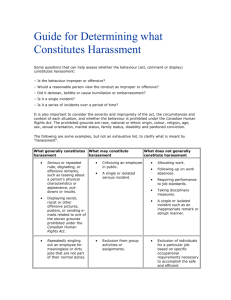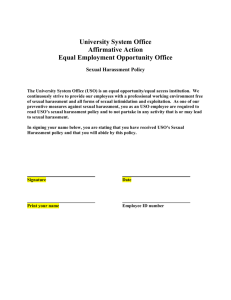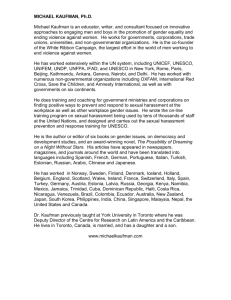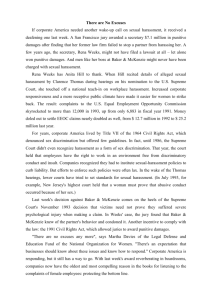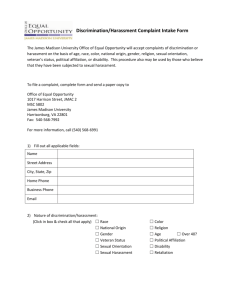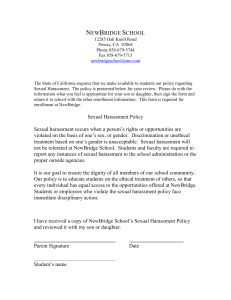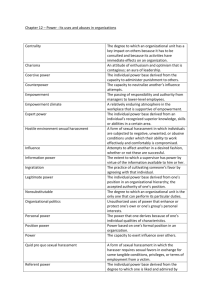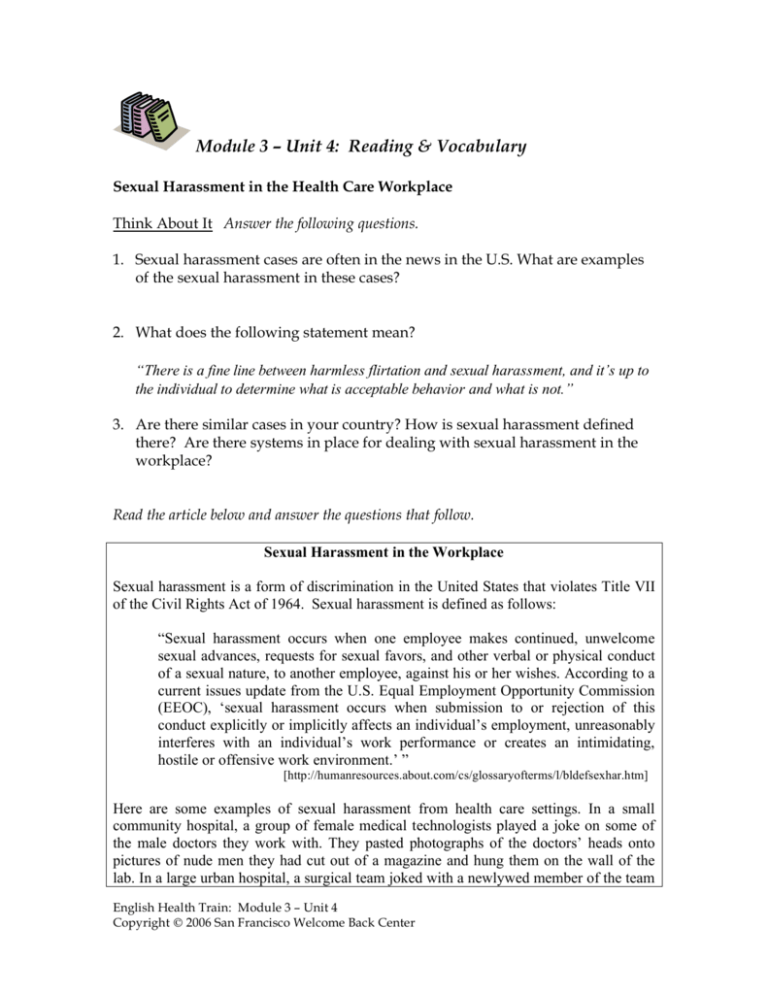
Module 3 – Unit 4: Reading & Vocabulary
Sexual Harassment in the Health Care Workplace
Think About It Answer the following questions.
1. Sexual harassment cases are often in the news in the U.S. What are examples
of the sexual harassment in these cases?
2. What does the following statement mean?
“There is a fine line between harmless flirtation and sexual harassment, and it’s up to
the individual to determine what is acceptable behavior and what is not.”
3. Are there similar cases in your country? How is sexual harassment defined
there? Are there systems in place for dealing with sexual harassment in the
workplace?
Read the article below and answer the questions that follow.
Sexual Harassment in the Workplace
Sexual harassment is a form of discrimination in the United States that violates Title VII
of the Civil Rights Act of 1964. Sexual harassment is defined as follows:
“Sexual harassment occurs when one employee makes continued, unwelcome
sexual advances, requests for sexual favors, and other verbal or physical conduct
of a sexual nature, to another employee, against his or her wishes. According to a
current issues update from the U.S. Equal Employment Opportunity Commission
(EEOC), ‘sexual harassment occurs when submission to or rejection of this
conduct explicitly or implicitly affects an individual’s employment, unreasonably
interferes with an individual’s work performance or creates an intimidating,
hostile or offensive work environment.’ ”
[http://humanresources.about.com/cs/glossaryofterms/l/bldefsexhar.htm]
Here are some examples of sexual harassment from health care settings. In a small
community hospital, a group of female medical technologists played a joke on some of
the male doctors they work with. They pasted photographs of the doctors’ heads onto
pictures of nude men they had cut out of a magazine and hung them on the wall of the
lab. In a large urban hospital, a surgical team joked with a newlywed member of the team
English Health Train: Module 3 – Unit 4
Copyright 2006 San Francisco Welcome Back Center
in the break room about her lack of private time with her husband. She was clearly
uncomfortable about the conversation.
Other examples of sexual harassment include:
•
•
•
•
•
inappropriate or suggestive remarks of a sexual nature
inappropriate touching or other physical behavior
comments or questions about your sex life (including questions about your
sexual orientation)
pornography displayed in the workplace or sent through email
requests or demands of a sexual nature
Research suggests that sexual harassment is a major challenge facing health care systems
today. In a large national survey reported on in Internal Medicine, 36% of the women
physicians surveyed said they had experienced harassment of a sexual or physical nature.
Many studies like these focus on physicians and physicians in training; however, many
human resource executives in health care agree that sexual harassment is even more of a
problem among non-physician staff.
Why are health care settings a breeding ground for sexual harassment? Possible reasons
include the fact that there is a hierarchical power structure in many health systems,
people work together in small teams for long hours, and the nature of the work is highly
intense and personal.
There is a fine line between harmless flirtation and sexual harassment, and it’s up to the
individual to determine what is acceptable behavior and what is not. Basically, if
something feels inappropriate, and if your requests for it to stop are ignored, there is a
good chance that you are being sexually harassed.
The EEOC states that harassment can occur in a variety of situations. These include:
•
•
•
•
•
•
The victim or the harasser may be a man or a woman.
The harasser can be the same sex as the victim.
The harasser can be the victim’s supervisor, manager, co-worker, or client.
The victim does not have to be just the employee who is the target of the
harassment. The victim could be anyone affected by the offensive conduct.
Sexual harassment can occur even when the person being harassed cannot claim
any negative effects such as economic injury or discharge.
The harasser’s conduct must be unwelcome.
How to Deal with Harassment
The first response to any inappropriate behavior is to ask the offender to stop. It is
important to very firm and clear in your request and to make it obvious that you find this
person’s actions offensive. If this doesn’t do the trick, you should document everything
English Health Train: Module 3 – Unit 4
Copyright 2006 San Francisco Welcome Back Center
that has taken place, noting the date and time of the inappropriate behavior and what
happened. If anything offensive has taken place in writing, for example, in an email, keep
a copy of these papers to use as evidence. It is also a good idea to tell a co-worker about
what is happening and to keep them informed if the offenses continue and of your plans
for dealing with them.
If the harassment does not stop, your next step is to follow the complaint system and
recommended procedures in the sexual harassment policies that are in place in your
workplace. This usually involves reporting the harasser to your employer, often the
director of human resources. This is often followed by an interview with you to start an
investigation. Do not be afraid to report the harasser, and to do it as soon as possible.
Employers would prefer to know about possible harassment, particularly if this is
affecting your work performance. Not only that, but you may find that others have also
suffered from this person’s behavior, so dealing with the issue may help your co-workers,
too.
It is the responsibility of all employers to develop a clear policy for preventing and
dealing with sexual harassment and to take each complaint of sexual harassment seriously
and to investigate. Sexual harassment is against the law, yet research suggests that only
5% of victims make a formal complaint. Know your rights and take action if you are
harassed!
Adapted from:
BBC. http://www.bbc.co.uk.health. Retrieved 12/20/04.
Workforce Development Group.
http://www.workforcedevelopmentgroup.com/news_nine.html.
About.com. Retrieved 12/20/04.
o http://womensissues.about.com/cs/sexdiscrimination/a/aasexualharass.htm.
Retrieved 12/20/04.
o http://humanresources.about.com/cs/glossaryofterms/l/bldefsexhar.htm.
Retrieved 12/20/04.
English Health Train: Module 3 – Unit 4
Copyright 2006 San Francisco Welcome Back Center
Questions About Reading
1. True or False. Verbal comments about your appearance or sex life are
examples of sexual harassment.
2. True or False. Sexual harassment only occurs between men and women.
3. True or False. When few women are promoted to leadership positions in a
health care organization, this is an example of sexual harassment.
4. True or False. Companies in the U.S. are required by law to have sexual
harassment policies and procedures in place for employees to make formal
complaints.
5. What are some reasons that sexual harassment is common in health care
settings?
6. In your own words, summarize the steps you should take if you are being
sexually harassed.
English Health Train: Module 3 – Unit 4
Copyright 2006 San Francisco Welcome Back Center
Vocabulary Practice
The language in legal documents includes specific terminology, such as legal jargon, and
is often difficult to understand. Read the excerpt in the first paragraph of the reading
again (from Title VII of the Civil Rights Act of 1964). Match the legal terms in the left
column below with the everyday language with the same meaning in the right column.
Write the correct letter on the line.
Legal Term
Everyday Language
a. not accepting nor giving in to
1. ___ conduct
2. ___ submission to
b. a setting or situation that is upsetting
or disgusting
3. ___ rejection of
c. behavior
4. ___ explicitly
d. indirectly
5. ___ implicitly
e. a setting or situation where you feel
worried or frightened
6. ___ unreasonably interferes with
f. giving in to
7. ___ an intimidating environment
g. directly
8. ___ an offensive environment
h. strongly prevents you from doing
what you need to do
English Health Train: Module 3 – Unit 4
Copyright 2006 San Francisco Welcome Back Center

